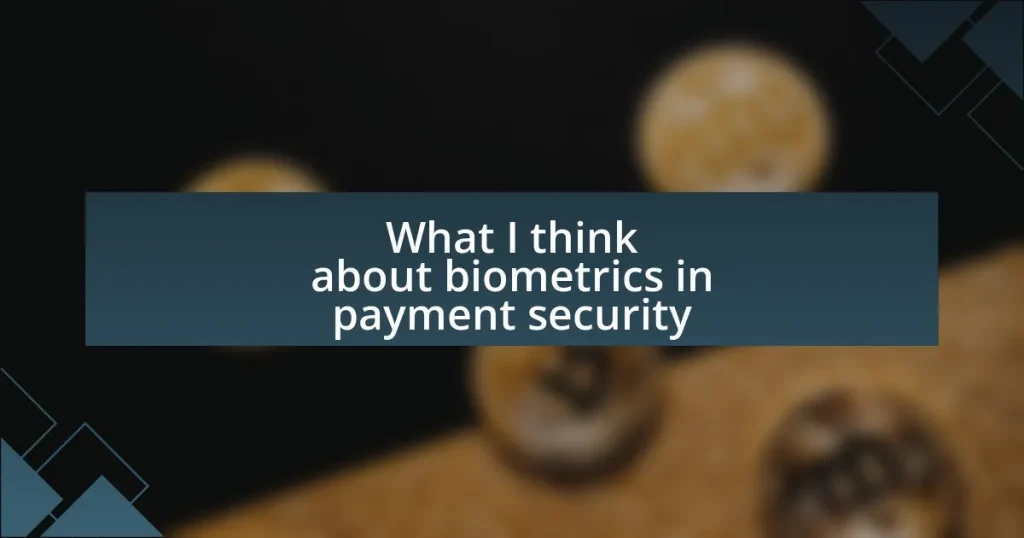Key takeaways:
- Biometric payment systems enhance security and convenience, minimizing fraud risks by using unique personal identifiers.
- Challenges include privacy concerns over biometric data storage, accuracy in recognition, and accessibility for all users.
- Future trends indicate a shift towards multi-modal biometrics, integration with wearable tech, and privacy-focused innovations like on-device processing.
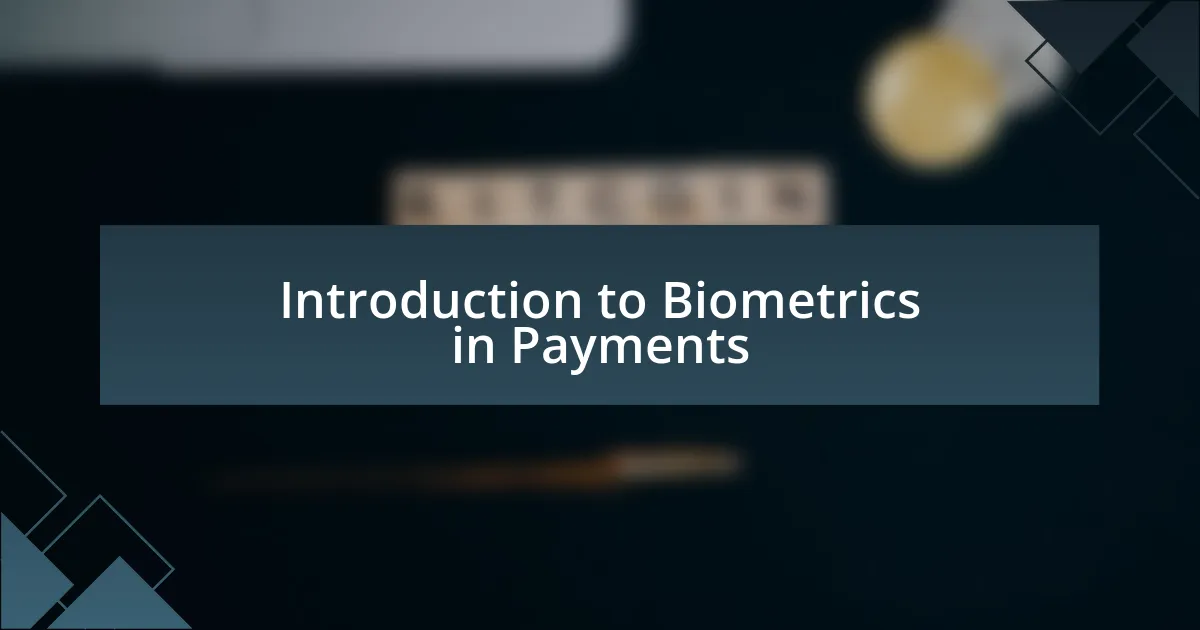
Introduction to Biometrics in Payments
Biometrics in payment security is a fascinating advancement that has transformed how we think about transactions. When I first started using fingerprint technology to unlock my phone, it struck me how seamlessly it integrated into my daily life. Wouldn’t it be remarkable if we could extend that same convenience and security to our purchases?
Consider the emotional aspect of security. Every time I tap my phone to make a payment, I feel an immediate sense of reassurance. Unlike traditional methods, which often require cumbersome passwords or cards, biometric systems like facial recognition and voice authentication offer a more personal layer of protection. Who doesn’t want to feel safer when making transactions?
As I delve deeper into the world of biometrics, I find myself intrigued by the potential for even more innovation. Imagine a future where our biological traits become the standard for securing not just payments but personal data as well. This evolution raises an important question: can we rely on technology to strike the right balance between accessibility and security in our financial transactions?
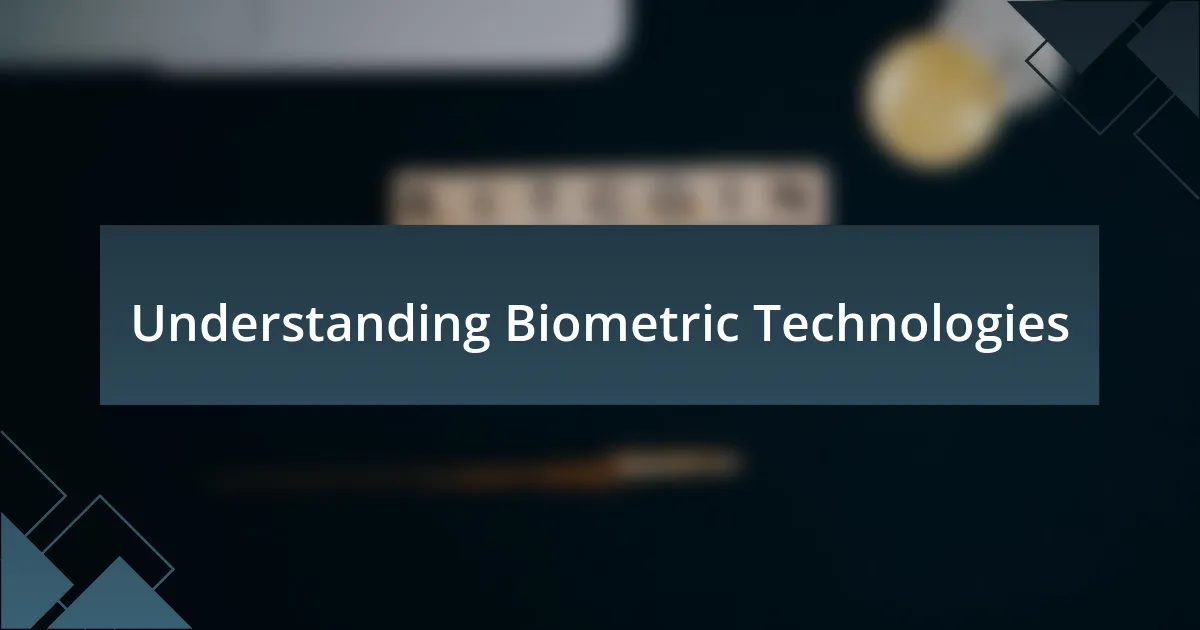
Understanding Biometric Technologies
Biometric technologies are gaining traction as a reliable method for securing payments. They analyze unique physical or behavioral characteristics, which makes them inherently personal. I remember the first time I used my face to access my bank app; it felt like a scene from a sci-fi movie, merging my identity with technology in a way that was both thrilling and reassuring.
Here are some common biometric technologies used in payment security:
- Fingerprint Recognition: Uses unique patterns on fingers, widely implemented in smartphones and ATMs.
- Facial Recognition: Analyzes facial features to unlock devices or authenticate transactions.
- Voice Recognition: Identifies the unique voiceprint of individuals, often used in call center transactions.
- Iris Recognition: Scans the unique patterns in the colored part of the eye, providing high security for sensitive transactions.
- Behavioral Biometrics: Monitors user behavior, like typing patterns or walking gait, to verify identity.
Each technology offers distinct advantages, but I often wonder about the balance between convenience and privacy. How do we ensure our personal data is protected while making transactions smoother and faster? It’s a delicate dance that has me excited about the future of payment security.
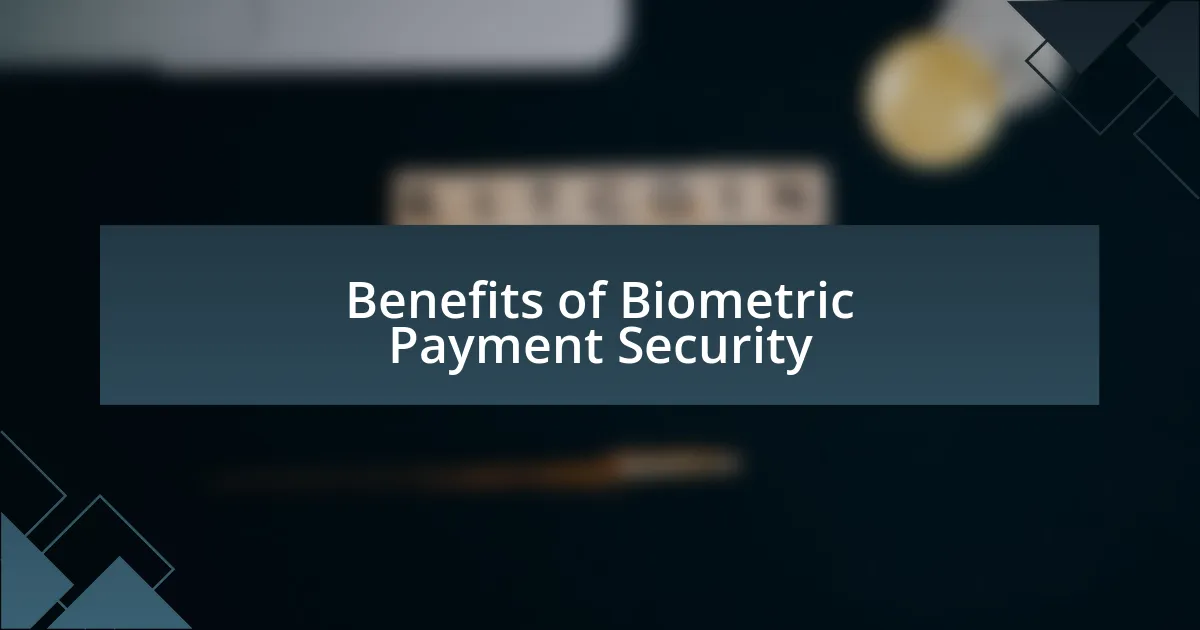
Benefits of Biometric Payment Security
Biometric payment security brings a profound sense of trust and convenience to the user experience. When I think about how quickly I can authenticate my transactions using my fingerprint, it’s hard not to appreciate the seamlessness it offers. No more fumbling for a card or remembering lengthy passwords; just a simple touch, and I’m good to go.
The uniqueness of biometric traits not only heightens security but also reduces fraud risk significantly. I remember a friend who had her credit card compromised, and the hassle she endured while dealing with the bank was overwhelming. With biometrics, that risk is minimized because it’s incredibly difficult for someone to replicate another person’s biometric identifiers, resulting in a much safer transaction environment. I can’t help but feel a little more secure knowing my identity is tied to something that’s literally part of me.
Moreover, biometric systems often speed up the payment process, enhancing customer satisfaction. For instance, I often find long lines at the grocery store tedious, but when biometric scanners are in place, transactions occur in a flash! It makes me think: why would anyone want to go back to traditional methods? The efficiency and user-friendliness of biometric payment systems seem to be paving the way for a future where our transactions are as simple as a glance or a touch.
| Benefit | Description |
|---|---|
| Enhanced Security | Biometric traits are unique and difficult to replicate, reducing fraud risk. |
| Convenience | Quick authentication speeds up the payment process, improving customer experience. |
| Personalized Access | Biometric systems link transactions directly to the individual, increasing trust. |
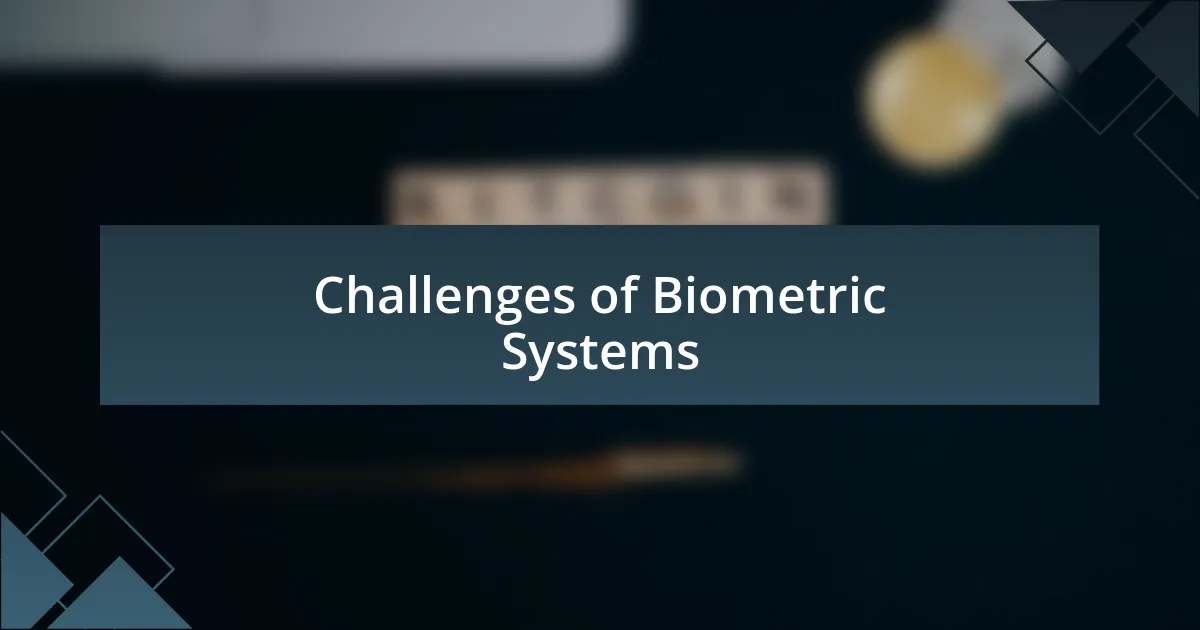
Challenges of Biometric Systems
When I consider the challenges of biometric systems, one significant concern is privacy and data security. The thought of my biometric data being stored and potentially hacked sends shivers down my spine. I can’t shake the feeling that once that information is out there, it could lead to identity theft in ways that traditional methods simply don’t. How safe is that data really?
Another hurdle is the accuracy of biometric recognition. All it takes is for a sensor to misread my fingerprint or for my face to be partially obscured, and suddenly my payment could be delayed or denied. I remember a time when I struggled to pay for my morning coffee because the scanner wouldn’t recognize my fingerprint due to moisture on my skin. It made me wonder: what happens during my rainy mornings or workouts when my hands aren’t in ideal condition?
Additionally, accessibility poses a significant challenge for some users. Not everyone has the same physical attributes or technological comfort levels. Reflecting on my experiences, I’ve seen friends with disabilities face hurdles when using biometric systems. It raises the question: are we inadvertently excluding certain groups by relying too heavily on these technologies? Balancing security with inclusivity is a conundrum that needs addressing as we look to fully embrace biometrics in payment security.

Best Practices for Implementing Biometrics
When implementing biometric systems, it’s crucial to conduct thorough testing. I recall a situation where a friend’s new fingerprint scanner at home frequently malfunctioned, leading to frustration during every transaction. Testing under various conditions, such as different lighting or wet fingers, can help identify potential issues and ensure a smoother user experience.
I also believe that user education plays a vital role in successful implementation. Once, I struggled to set up voice recognition on my phone until I watched an instructional video. Clear guidance on how to use biometric features—including what factors can affect accuracy—can significantly enhance user trust and satisfaction.
Lastly, data security measures cannot be overstated. I often wonder how many people genuinely feel secure knowing that their biometric data is stored online. Employing encryption methods and ensuring that biometric data is anonymized can go a long way in reassuring users while also protecting their sensitive information from potential breaches.
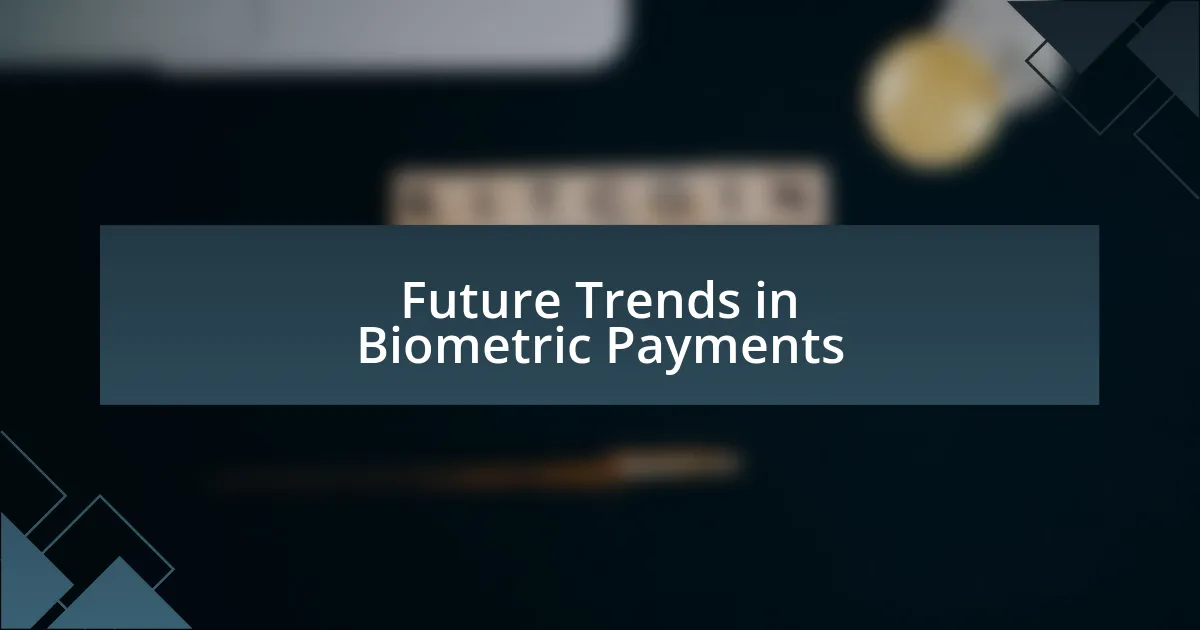
Future Trends in Biometric Payments
As we look to the future of biometric payments, one significant trend is the rise of multi-modal biometrics. I remember a time when I felt vulnerable relying solely on a single form of authentication. By combining various biometric methods, like facial recognition and voice authentication, systems can create a more robust security environment. This not only enhances security but also improves user experience, making transactions feel more seamless.
Another fascinating development is the integration of biometric payments with wearable technology. I can’t help but reflect on how handy it would be to make purchases with a simple touch of my smartwatch. Wearables not only offer convenience but also facilitate secure transactions without the need for physical cards or even smartphones. It’s intriguing to think about how this trend could reshape our daily purchasing habits, making payments as effortless as glancing at a device.
Moreover, the growing emphasis on privacy-enhancing technologies will play a crucial role in shaping the future of biometric payments. I often think about my own hesitations when sharing personal data. Innovations like on-device processing, which securely stores biometric data without ever transmitting it, can alleviate user concerns. This shift not only reassures users about their privacy but also encourages wider adoption of biometric solutions in financial transactions.
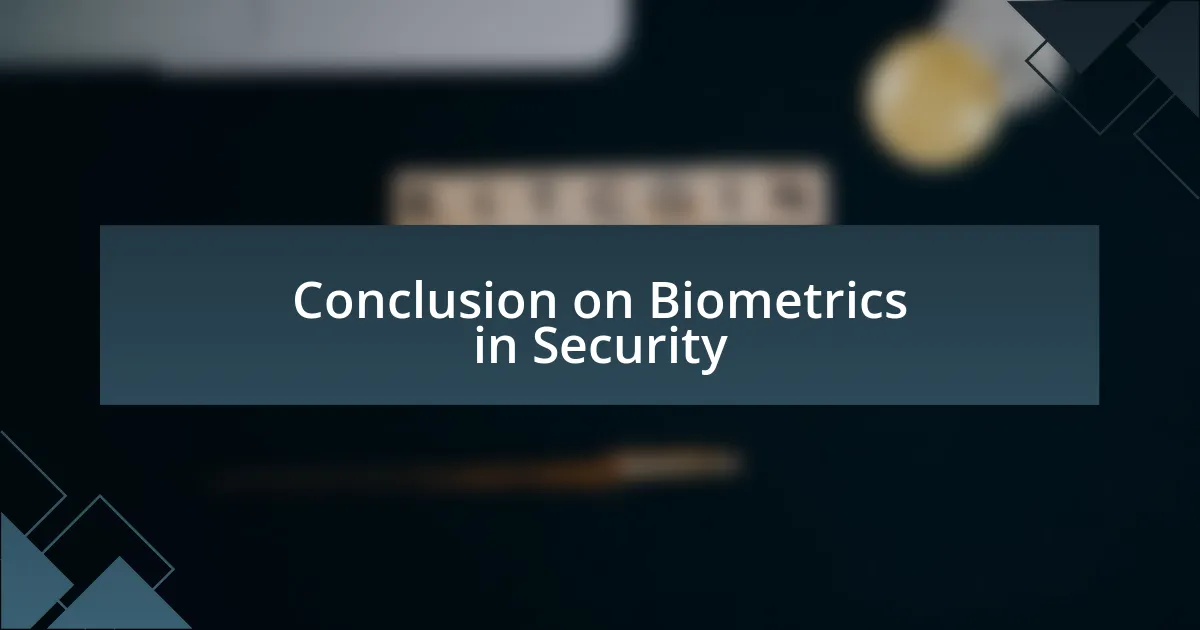
Conclusion on Biometrics in Security
When reflecting on the effectiveness of biometrics in payment security, I believe it’s clear that they offer a unique blend of safety and convenience. For instance, I once faced the frustrating experience of forgetting my card at home while out shopping. Since incorporating biometric authentication into my payment methods, I’ve gained a sense of peace, knowing that my identity is secured by something I always carry with me—my fingerprint or my face.
Additionally, as advancements continue, I can’t help but worry about the potential vulnerabilities that may arise. With every innovation comes the challenge of ensuring those systems are still resistant to hacking or misuse. Do we trust that the technology will stay ahead of the nefarious tactics emerging alongside it? Personally, I stay optimistic, yet vigilant, feeling there’s still much to learn about the delicate balance between convenience and security.
Ultimately, the future of biometrics in payment security isn’t just about technology but also about building trust. I recall a friend who was hesitant to switch to biometric payments because he felt his privacy would be compromised. It took some thoughtful discussions, and real-life examples of how biometric systems are designed with privacy in mind, to help him understand their potential. This trust plays a key role in broader acceptance, and as technology evolves, so must our confidence in it.











